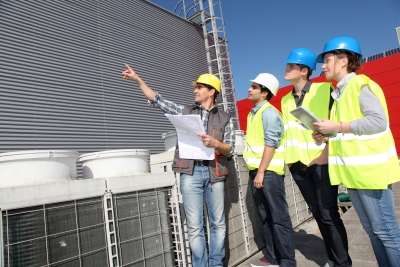General Industry Walking-Working Surfaces and Fall Protection Standards
On November 17, 2016, OSHA issued a final rule on Walking-Working Surfaces and Personal Fall Protection Systems to protect workers in general industry from falls. Fall hazards from heights and on working surfaces are one of the leading causes of serious workplace injuries and deaths, and the new rule more closely aligns general industry requirements with those in construction.
In the works since 1990, the new rule updates and clarifies the walking-working surface standards and adds clear training and inspection requirements. The final rule will allow employers to select a fall protection system that works best for 
- Guardrail Systems
- Safety Net Systems
- Personal Fall Arrest Systems
- Positioning Systems
- Travel Restraint Systems
- Ladder Safety Systems
One of the most significant changes will be to fixed and portable ladders and the safety requirements surrounding them. Cages and wells will no longer be acceptable forms of fall protection on fixed ladders higher than 24 feet, although employers will have a generous timeframe – up to 20 years in some cases – to phase in ladder safety systems or personal fall arrest systems (PFAS).
The rule will be effective on Jan. 17, 2017, and will affect approximately 112 million workers at seven million worksites. OSHA estimates the final standard will prevent 29 fatalities and more than 5,842 lost-workday injuries annually.
Alignment With Construction Standards
Because many employers perform activities that fall under both general industry and construction standards, the new final rule eases compliance by bringing many of the general industry standards in line with current construction standards.
More specifically, construction standards (29 CFR part 1926) are referred to in the following parts of the new Walking-Working Surfaces standard (29 CFR part 1910, subpart D):
- 27(a) Scaffolds – Scaffolds used in general industry must meet the requirements in construction 29 CFR part 1926, subpart L (Scaffolds).
- 28(b)(1)(ii) Unprotected sides and edges – When the employer can demonstrate that it is not feasible or creates a greater hazard to use guardrail, safety net, or personal fall protection systems on residential roofs, the employer must develop and implement a fall protection plan that meets the requirements of construction 29 CFR 1926.502(k) and training that meets the requirements of 29 CFR 1926.503(a) and (c).
- 28(b)(12) Scaffolds and rope descent systems – The employer must ensure: (i) Each employee on a scaffold is protected from falling in accordance 29 CFR part 1926, subpart L; and (ii) Each employee using a rope descent system 4 feet (1.2 m) or more above a lower level is protected from falling by a personal fall arrest system.
- 29(b) Guardrail systems Note to paragraph (b) of this section: The criteria and practices requirement for guardrail systems on scaffolds are contained in 29 CFR part 1926, subpart L.
- 29(c) Safety net systems – The employer must ensure each safety net system meets the requirements in 29 CFR part 1926, subpart M.
What You Need To Know
The following subparts of 29 CFR part 1910 will be affected by this final rule:
Subpart D – Walking-Working Surfaces (see table below):
Subpart I – Personal Protective Equipment:
- Addition of 1910.140 Personal Fall Protection Systems.
- Addition of 1910 Subpart I App C – Non-Mandatory Guidelines for Personal Fall Protection Systems
- Addition of 1910 Subpart I App D – Non-Mandatory Guidelines for Test Methods and Procedures for Personal Fall Protection Systems
Amendments to subparts for reference to subparts D and I only:
- Subpart F – Powered Platforms, Manlifts, and Vehicle-Mounted Work Platforms
- 1910 Subpart N – Materials Handling and Storage
- Subpart R – Special Industries
Important Dates To Remember
The new final rule goes into effect on January 12, 2017; after which, employers will need to complete training, installation, inspection and certification by the following dates:
May 17, 2017
Training workers on fall and equipment hazards
1910.30(a) and (b)
November 20, 2017
Inspection and certification of permanent building anchorages for rope decent systems
1910.27(b)(1)
November 19, 2018
Installation of fall protection (personal fall arrest systems, ladder safety systems, cages, wells) on existing fixed ladders (over 24 feet) that do not have any fall protection
1910.28(b)(9)(i)(A)
November 19, 2018
Installation of personal fall arrest systems or ladder safety system on all new fixed ladders (over 24 feet) and replacement ladders/ladder sections
1910.28(b)(9)(i)(B)
November 18, 2036
Installation of ladder safety systems or personal fall arrest systems on all fixed ladders (over 24 feet)
1910.28(b)(9)(i)(D)
Compliance Assistance Materials
Below are some convenient links to information directly from OSHA regarding the new final rule on Walking-Working Surfaces and Fall Protection Standards:
Optimum Safety Management Can Help You Get Compliant
If you’re not sure how the new final rule applies to you, Optimum Safety Management can help. As the walking-working surfaces and fall protection standards for general industry have not been updated for some time, it’s understandable that many employers are going to require clarification and assistance with their compliance responsibilities.
Contact Optimum Safety Management at 630-759-9908 for a free consultation and information about how we can help you evaluate, update and implement a new safety management plan to meet the requirements of the new final rule.








